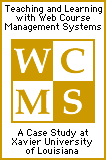Teaching and Learning with Web Course Management Systems

WebCT and a Course in Genetics
Todd Stanislav (Biology Department and Center for the Advancement of Teaching)
During the spring 2001 semester, I used WebCT as a Web course management system in my Genetics lecture course. The following WebCT functionalities were used:
- Links to course-related websites
- Asynchronous communication concerning, for example:
- Student feedback on quizzes and exams
- Clarification and further discussion of course content presented in class
- Discussion of course-related subjects that were otherwise not presented in class
- Document sharing (e.g., sample quizzes and exams).
My use of WebCT resulted in three important lessons:
- For most students, but fortunately not all, there are two things that motivated them to use the technology:
- Directly, points toward a grade.
- Indirectly, points toward a grade.
- Replacing the face-to-face meetings with on-line course activities in a very "traditional" course proved extraordinarily difficult.
- Creating a truly hybrid course comprised of traditional and on-line components is far more difficult than simply adding on-line content and activities to a traditional face-to-face course.
Regarding the first lesson, I am inclined to give the students the benefit of the doubt. In hindsight, I did not create an environment, which, by itself, was conducive to the students' use of the technology. To be sure, most students view course content and activities largely through the lens of the "bottom line." That is, students want to know what is "in it" for them. Hands down, the bottom line has to do with their grades. As one student commented in the end-of-semester evaluation of the course, "Continue giving extra credit on WebCT."
Forever the challenge in contemporary education is to help students know what it means to learn liberally! The lesser challenge, which I met unsuccessfully, was in developing on-line course content and learning activities with "intrinsic value," that is, value that captured the students' imagination and desire to learn.
Second, the on-line learning activities for this course relied almost exclusively on conversation and discussion, a means of learning that our students in the sciences at Xavier see, perhaps, as less central to the overall learning process. I'll be quick to admit that the "social construction of knowledge" as a teaching and learning method is one on which I place great value but to which I have given embarrassingly little class time. In the final analysis, I would like to have developed a course, as one student also noted, with "(m)ore interaction on WebCT."
Regarding lesson number two, I have taught this course for nine years and become all too comfortable in teaching it as a traditional face-to-face course. To be sure, this has, by and large, worked for most students. Although I have used information technology, active learning activities, case studies, and other teaching and learning strategies to varying degrees, the lecture has been a mainstay of the course. When faced then with the opportunity to replace as much as one-third of the face-to-face class time with on-line activities, I encountered the proverbial brick wall. Although I experimented with on-line assignments and discussion, their impact, though not measured formally, was minimal, I fear.
Finally, my goal was to create a new course that was a hybrid of the traditional face-to-face and new on-line content and activities. The course, though different than the previous semester's course, was a traditional face-to-face course to which an on-line component was simply added. Although one student noted the major strength of the course being, "The fact that a Web Course Management System was used which served as an additional supplement to students." I was nonetheless dissatisfied with the final "product." To point out the obvious, I simply need to rethink the entire course structure, with particular attention to: elements of the course that I wish to either preserve or change; student learning outcomes; student-centered teaching strategies; and new and effective teaching and learning resources in Genetics.
<-- Prev. Section | Next Section -->
WCMS: Home | Executive Summary | Final Report | Narratives and Data | Findings | RealVideo Tour | Webliography
![[Xavier Seal]](/images/xavier-seal.png)
![[CAT+FD Logo]](/images/cat-site-icon.png)